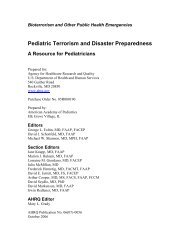H1N1 COUNTERMEASURES STRATEGY AND ... - PHE Home
H1N1 COUNTERMEASURES STRATEGY AND ... - PHE Home
H1N1 COUNTERMEASURES STRATEGY AND ... - PHE Home
You also want an ePaper? Increase the reach of your titles
YUMPU automatically turns print PDFs into web optimized ePapers that Google loves.
NBSB Pandemic Influenza Working Group<br />
Detailed Report<br />
prompted NIAID to develop a SARS plasmapheresis study. Dr. Beigel said it took about<br />
18 months to establish a SARS IVIG protocol, but the study eventually collected about<br />
30 liters of convalescent plasma (much less than expected). By the time this was<br />
collected and manufactured into a IVIG product (lab scale), the end product lacked hightiter<br />
antibodies. The timeline from concept to product (GLP IVIG) was 4.5 years.<br />
The threat of H5N1 also required a quick treatment, and there were concerns about<br />
resistance. Dr. Beigel said getting convalescent plasma from areas affected by H5N1<br />
may be even harder than getting it from Hong Kong, so he and his colleagues developed<br />
a hyperimmunization plasmapheresis program for H5N1. The concept of plasma<br />
treatment for influenza was supported by a paper looking at eight studies during the 1918<br />
influenza pandemic. The paper described the use of convalescent plasma for sick people<br />
and noted they had a lower mortality rate than others. Again, the study would not meet<br />
modern standards, but it offered some insight.<br />
Early studies of hyperimmunized horse serum showed some protection in mice.<br />
Prompted by these studies and the H5N1 vaccine studies, Dr. Beigel designed a multiplecohort<br />
study in which each cohort received higher doses than previously studied (90, 120,<br />
or 180 mcg), for four doses, in an effort to increase antibody titers. Both hemaglutination<br />
inhibition (HI) and microneutralization (MN) did not increase with higher doses of<br />
vaccine but did increase with subsequent vaccinations. However, serial vaccination did<br />
not increase the number of subjects who got to high-titer antibodies of HI (above 1:160).<br />
The subjects chose their vaccine sites, with early data suggesting those receiving vaccine<br />
in the arm had higher HAI titers; so the study added a fourth cohort that received two<br />
doses of the vaccine in the deltoid or the buttock. Overall, the study had 126 subjects, 10<br />
of which met the criteria for plasmapheresis. From those 10, investigators got about 30<br />
liters of plasma. Nine units were manufactured into IVIG. Dr. Beigel said the titer of the<br />
output was higher than the input, but much lower than expected. Studies evaluating this<br />
are ongoing. The process for the IVIG effort took 2.5 years from concept to product. If<br />
preclinical and phase-1 trials were needed, the process would take even longer. Dr.<br />
Beigel broke down the timeline into the component parts and discussed each one’s issues.<br />
For example, manufacturing IVIG instead of using source plasma adds several months<br />
from the last unit of plasma collected (although in an urgent setting, it’s possible the<br />
manufacturing process could be faster). Plasma is less expensive to manufacture. From a<br />
scientific standpoint, IVIG is preferred because antibody titers can be standardized and<br />
there are no confounding factors such as different drug volumes.<br />
Plasma collection and development of IVIG are not as rapid as people think. Some steps<br />
could be optimized. The use of source plasma as the therapeutic could improve the<br />
timeline by 6–12 months, but you sacrifice some scientific benefits.<br />
Dr. Beigel then compared polyclonal and monoclonal antibody-based treatment for<br />
emerging infectious diseases:<br />
77
















